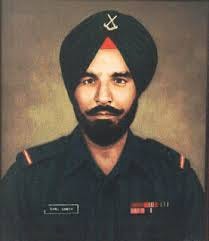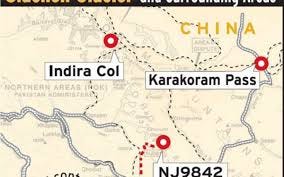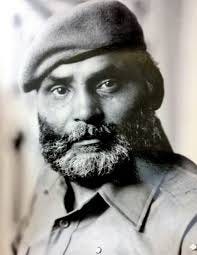Subedar Bana Singh
Siachen, which ironically means “Rose Garden” in local Balti language, located in Eastern Karakoram, it is 75 km long, and is the highest battlefield in the world. The 110 KM line beyond NJ9842 is called the Actual Position Ground Line.
Background
The genesis of the Siachen conflict lay in Partition, after the first Indo-Pak war, the 2 nations agreed on the ceasefire line. The problem is that the line was not demarcated beyond a point NJ9842, as it was an inhospitable area. The agreement simply said that the beyond NJ9842, the line would run North of the glaciers, which included Siachen, Rimo and Baltoro. It was believed that no military operations would take place there at those inhospitable areas, and both sides, did not care much about it.
After the ’71 war, as per the 1972 Shimla Agreement, this ceasefire line became the LOC, and once again the Siachen glacier was left out. As it was considered an inhospitable area, no attempt was made to enforce jurisdiction over it. And this was a blunder by the Indian establishment, as Pakistan had already begun making changes in it’s maps to include Siachen within it’s ambit. Between 1964-72, a series of maps by Pak, showed Siachen as part of it, and this was accepted globally too.
While India contended that the Pakistan’s territorial limits lay only till Saltoro Ridge, Pak contended that territory was till Karkoram.For a large part of the 70’s and early 80s, there were rival mountaineering expeditions, to climb the peaks located in the Siachen region. Col Narendra Kumar led one of the first Indian expeditions to Siachen in 1978, undertaking a 24,631 foot ascent to Teram Kangri. Nicknamed “Bull”he also pointed out that while Pakistan allowed mountaineers from all over, India denied access to it’s own soldiers there.
The fact is way till 1978, Indian establishment, did not consider Siachen as much of significance, being an inhospitable area. While Pakistan all this time, was allowing international mountaineers there, and claiming it in it’s maps. However when the Pakistani Army sent a warning note in 1982, asking India to keep out of Siachen, Chibber who was then the Northern Army commander, countered back, and patrols were set up in that region.
By the end of 1983, it was obvious to India that Pakistan was moving it’s troops to Siachen to occupy it. Intelligence reports had shown large scale troop movement by Pakis, as also purchase of high altitude gear in large numbers from Europe.
The trigger to Operation Meghdoot was the Pak Govt allowing a Japanese expedition on Rimo I, one of the important peaks in 1984.Overlooking the northwestern part of Aksai Chin, that is occupied by China, Rimo I, was a strategically important peak in Siachen. This operation ensured that India captured nearly 2600 sq km of territory in Siachen, as well giving a tactical advantage.
The other important operation was Operation Rajiv, that aimed to capture a high point along the Actual Ground Position Line on Siachen Glacier in June 1987.
This area was under the control of the Pakistani forces who had established a post called Quaid Post at an altitude of 6500m , named after Md.Ali Jinnah. The Pakistani army had a clear view of the entire Saltoro Range and Siachen glacier from where they could snipe on the Indian army at will. The enemy post flanked by ice walls on either side was virtually an impregnable fortress.
Two soldiers were killed on April 18, 1987 at Point Sonam, while on May 29, an attempt to capture the post ended in failure, with the death of 2nd Lt Rajiv Pande who led the mission. The military operation named in his honor, was led by Major Varinder Singh.
The hero of this operation would be Naib Subedar Bana Singh, born on January 6, 1949 in a small village near Jammu. Joining the Indian army in 1969, he began service with the 8th Battalion of the Jammu and Kashmir Light Infantry. He was trained at the High Altitude Warfare School in Gulmarg, and was promoted to Naib Subedar in 1985.
On June 26, 1987 Bana Singh led a 5 member team that climbed the steep 457 m wall of ice protecting the post. They approached the Quaid post from another less guarded direction, that was a longer and more difficult route. A very severe blizzard also gave cover to the team. On reaching the post, Bana Singh found a single bunker there, into which he lobbied grenades, killing all those inside. He led the team in a fierce hand to hand combat with the Pakistani soldiers outside, bayoneting some of them. So furious was the assault that some of the Pakistani soldiers jumped off the cliff.
Bana Singh was awarded the Param Veer Chakra for his bravery and courage under fire, and the post was renamed as Bana Top in his honor. During the Kargil War, he was the only living PVC recipient, who was still serving in the army. Promoted to Subedar in 1992 and Major Subedar in 1996, he finally retired from the Army in October 2000. His son Rajinder Singh too joined the Army in 2008.







